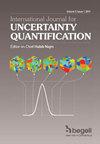闭合律模型不确定性量化
IF 1.8
4区 工程技术
Q2 ENGINEERING, MULTIDISCIPLINARY
International Journal for Uncertainty Quantification
Pub Date : 2021-01-01
DOI:10.1615/int.j.uncertaintyquantification.2021037714
引用次数: 0
摘要
工业过程仿真器预测的不确定性是由于输入变量的不确定性和模型规格的不确定性,特别是闭合律的不确定性。在这项工作中,将每个封闭律中的不确定性建模为一个随机变量,并优化其分布参数,以正确量化预测中的不确定性。我们开发了两种优化方法,基于积分二次距离和能量评分。以液体体积分数和压力梯度为输出变量,将该方法应用于商用多相流模拟器LedaFlow。分析了两个数据集。两者都描述两相气液流动,但在其他方面有根本不同。一种是以气体为主的分层/环空流动,另一种是以液体为主的段塞流。气壁摩擦系数的闭合规律对于以气体为主导的预测具有决定性作用,根据不同的方法,估计的相对标准偏差为4.5%或8.0%。以液体为主导的研究表明,液壁摩擦系数和段塞流泡速度是影响最大的闭合规律。估计液壁摩擦系数的相对标准偏差为5%,段塞流泡速度的相对标准偏差为4%。我们使用直接测量段塞流气泡速度来验证估计的不确定度。本文章由计算机程序翻译,如有差异,请以英文原文为准。
Closure Law Model Uncertainty Quantification
The prediction uncertainty in simulators for industrial processes is due to uncertainties in the input variables and uncertainties in specification of the models, in particular the closure laws. In this work, the uncertainty in each closure law was modeled as a random variable and the parameters of its distribution were optimized to correctly quantify the uncertainty in predictions. We have developed two methods for optimization, based on the integrated quadratic distance and the energy score. The proposed methods were applied to the commercial multiphase flow simulator LedaFlow with the liquid volume fraction and pressure gradient as output variables. Two datasets were analyzed. Both describe two-phase gas-liquid flow, but are otherwise fundamentally different. One is gas-dominated stratified/annular flow and the other is liquiddominated slug flow. The closure law for the gas-wall friction factor is decisive for the gas-dominated predictions, and the estimated relative standard deviation is 4.5% or 8.0% depending on method. The liquid-dominated study showed that the liquid-wall friction factor and the slug bubble velocity are the closure laws with the greatest impact. Moreover, the estimated relative standard deviation in the liquid-wall friction factor is 5%, and the deviation in the slug bubble velocity is 4%. We used direct measurements of the slug bubble velocity to validate the estimated uncertainty.
求助全文
通过发布文献求助,成功后即可免费获取论文全文。
去求助
来源期刊

International Journal for Uncertainty Quantification
ENGINEERING, MULTIDISCIPLINARY-MATHEMATICS, INTERDISCIPLINARY APPLICATIONS
CiteScore
3.60
自引率
5.90%
发文量
28
期刊介绍:
The International Journal for Uncertainty Quantification disseminates information of permanent interest in the areas of analysis, modeling, design and control of complex systems in the presence of uncertainty. The journal seeks to emphasize methods that cross stochastic analysis, statistical modeling and scientific computing. Systems of interest are governed by differential equations possibly with multiscale features. Topics of particular interest include representation of uncertainty, propagation of uncertainty across scales, resolving the curse of dimensionality, long-time integration for stochastic PDEs, data-driven approaches for constructing stochastic models, validation, verification and uncertainty quantification for predictive computational science, and visualization of uncertainty in high-dimensional spaces. Bayesian computation and machine learning techniques are also of interest for example in the context of stochastic multiscale systems, for model selection/classification, and decision making. Reports addressing the dynamic coupling of modern experiments and modeling approaches towards predictive science are particularly encouraged. Applications of uncertainty quantification in all areas of physical and biological sciences are appropriate.
 求助内容:
求助内容: 应助结果提醒方式:
应助结果提醒方式:


